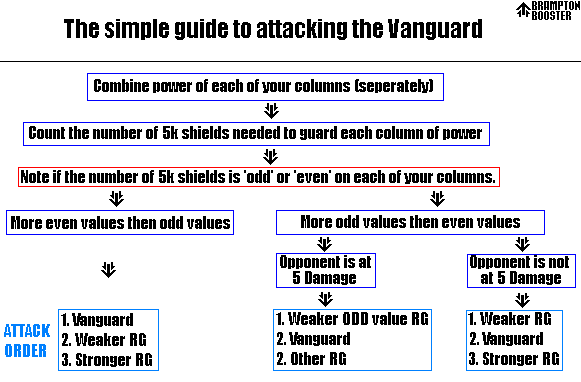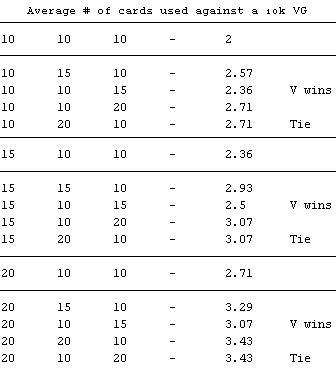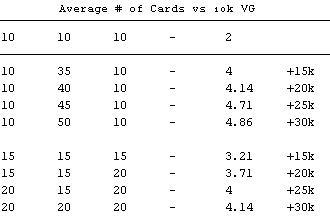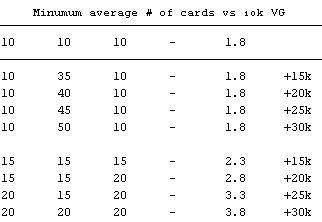Investigation on Power
- Brampton Booster
- Dec 23, 2012
- Comment
Investigations are boring. Even if vanguard happens to be the subject.
Hearing about investigations aren’t (sometimes). Using the data I collected, I found some pretty neat info I want to share with you.
I first used my awesome GuardChartver1.0.xls and set up a large amount of scenarios to gather the data. Since not everyone can understand logic, and I’m too lazy to do mathematical proof, I’m just going with examples. I recorded some scenarios into this sheet, containing the Combined Average Hand Size of nearly all positions of power from 10k to 25k: CommonScenarios.xls
It’s a little messy, since it was originally for my purposes, but I decided to display it anyways.
Investigation 1:
The best way to attack.
I’ve stated the best way to attack in my previous post, but no proof to show my case. Here, I will show you the basis for my proposed chart (shown below) on the next two investigations.

Taking the CommonScenarios sheet, these are the powers of units that faired BETTER when attacking R > V > R then V > R > R.
10:10:10 10:10:15
10:10:20 15:10:20
20:10:20 10:20:10
10:20:15 10:20:20
15:20:20 20:20:20
Why do they all look so similar? Excluding the columns with 15k, all of them seem to be in the 10’s and 20’s
Now we turn to when V > R > R is better then R > V > R
15:10:15 10:15:15
15:15:15 15:15:20
15:20:15 10:25:15
15:25:15 15:25:20
A lot of 5’s. This is a nice point. This means the more odd powered columns there are, the best you are to start with your vanguard. If we look back at the previous scenarios, an R > V > R is better with more even powered columns.
Now, as I was making the chart, it was quite hard to decide how I should explain it. I could of asked for a difference power truncate to the 5; I could also have looked at powered columns. But the final product sort of comes from Alice’s column notation. Rather I took a step back from her method and concerned myself with even and odd.
But here’s something confusing. An even powered column requires an odd powered guard, and vice versa. Please do not get confused with something that needs 5000 to guard versus something that is 5000POWER more then the vanguard.
*NOTE: Any scenario not covered means that both V > R > R deal the same as R > V > R. More factors are needed to determine the correct plan.
Investigation 2:
Weak > VG > Strong or Weak < VG < Strong?
Taking only the top bar we order the power levels from weakest to strongest and check for a RML or LMR attack scheme.
LMR Wins RML Wins Tie
10:10:15 15:10:20 10:10:10
10:20:15 15:20:20 10:15:10
10:30:15 15:30:20 10:20:20
10:10:25 25:10:30 20:15:20
20:20:25 25:20:30 20:25:30
20:30:25 25:30:30 30:10:30
The results might surprise you. When LMR wins, the even powered columns are on the left side. When RML Wins, the even powered columns are on the right die, EVEN when the power of the columns. And when the even columns are on BOTH sides, noone is better.
It looks like it does not matter what the strength of the rearguard columns are, but what level(even/odd) they are on. With that said, I draw the conclusion that the best way to attack in the R > V > R format is by starting with the LOWEST EVEN POWERED COLUMN, or LOWEST ODD VALUE COLUMN (It can get confusing. I mess it up a few times already).
Investigation 3:
How much guard does a vanguard exert on the opponent? (Not counting on-hit effects)
How much guard does a rearguard exert on the opponent? (Not counting on-hit effects)
Which is better?

I think this is the best way to display my results for this investigation. To investigate on the power difference on VG vs RG is all over the place. Especially since it is hard to separate the power difference. Instead I considered why you would want to use these results. And the most common time to use it is when you have more attackers then boosters. So I set up a 10:10:10 (three attackers, 1 available booster), 15:10:10 (2,1) and 20:10:10. Most boosters would allow a 5k boost to any unit, but vanilla boosters + attacker extra boosting power can send it into the 20 range.
The answer is slightly obvious. Having a booster behind the vanguard is the best option in terms of power at low levels. But if you manage to add 10k to a rearguard column then go with it. Also, if you extrapolated the data you will see that a power level that needs an odd amount of guard to stop is more beneficial to the vanguard, while even values compliment rearguards.
Investigation 4:
Is it better to focus on one column or power columns individually?
Let’s look up to a maximum of 30000.

Wow. Did you expect this? Well you should, because this is the average out of all scenarios (like guarding the VG). Given a 10:50:10 and <5 damage what would you do? Hopefully you’ll either use a PERFECT DEFENSE or declare a NO GUARD. Below is the same scenario, but instead we look at the LOWEST amount of guard the opponent can choose:

This is a bit more accurate. But do think about the above chart for a few moments. Considering you are at five damage and you do not have any perfect guards, you can be shelling out 7 cards to stop one turn of attacks. Honestly, running perfect guards makes comebacks a whole lot easier. You don’t need to waste your chance smacking yourself if you got a heal trigger or not.
Summary
Put boosters behind the vanguard if it would bring it to an odd value and before a rearguard if it would produce an even value.
Do not focus power on one column (unless your opponent is at 5 damage and without perfect guards, where it is actually better).
Take this experiment as a basis for your plans. In an actual game there are a lot more factors which decide what you should do.
Conclusion
I hope after you read this it will improve your mindset in the battle phase, and not to make any glaring misplays. If you haven’t already try to set one of your decks and see which catagories are more likely to show up in a real fight. The guardchart provides a detailed look at each of your columns, but the simplifed chart should be memorized for quick and dirty fights (If you experiment with several decks then it is more convenient just to run a quick scan then recall all the different scenarios and plays). And finally, the guard chart provides you with the best reaction to the best attack scheme for your opponent, but does not contain any actual probabilities on how likely each situation is. Always adapt to every change in a game.
